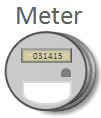About Meters

Meters are a type of device, which can be physical or virtual objects, that can produce data to be handled by the system.
A meter can have one or more device configurations over time. A meter's measuring components (if applicable) are associated with the device via device configurations.
A meter's device category (defined as an option on the device's business object) defines the broad category to which a particular device belongs. This option is used by smart meter commands and other processes when determining how the system should behave when executing processes based on the category of device. For example, when viewing items via the Device portal, certain item-specific zones appear that are not displayed when viewing meters or communication components. The base package supports the following device categories for meters:
-
Smart Meter: these meters are associated to a head end
system and support smart meter commands. The measuring components
associated to these devices are expected to be read very frequently.
These meters support periodic estimation.
Refer to About Periodic Estimation for additional functional information about how the periodic estimation can fill in missing reads for both interval and scalar measuring components.
- AMR Meter: these meters may also be associated to a head end system but they do not support smart meter commands. The measuring components are read frequently.
- Manual Meter: these meters are seldom read and do not support smart meter commands.
Attributes used to define devices include the following:
- Basic information about the Device including type of device (Smart Meter, Manual Meter, and so on), Manufacturer, and Model
- One or more device identifiers such as serial number, badge number, meter number, etc.
- For smart meters the device can also specify a head end system and an incoming data shift. Note: these fields are only necessary when there is no fallback defined on the device type.
Refer to Initial Measurement Data for additional functional information about how the device's head end system and incoming data shift can impact processing.
About Communication Modules
Communication modules enable automatic meter reading for manual meters, and handle electronic transmission of measurement data and events for meters that are not capable or not enabled to handle this data. Devices of this sort are attached to manual meters as equipment, and in the case of modules that measure consumption or other data, are associated to the physical meter’s scalar measuring components.
Communication modules associated with a manual meter are defined in the Device Equipment list on the Manual Meter business object (D1-ManualMeter). See the embedded help for more information.
Creating Measuring Components for Communication Modules
Measuring components used with communication modules must be scalar register measuring components (based on the D1-Register business object) and must be defined on the manual meter's device configuration.
If the communication modules will also record interval consumption, create an interval channel measuring component (based on the D1-IntervalChannel business object) add it to the manual meter's device configuration, and add it as the register measuring component’s Consumption Reference Measuring Component.
Measurement and Device Event Processing for Communication Modules
The IMD Seeder and Device Event Seeder support payloads that reference the communication module identifiers currently attached to a physical meter, instead of the physical meter's identifier.
Based on the physical meter and the communication module currently attached to it, the seeders can identify the physical meter’s register (or related interval) measuring component and use it for instantiating the initial measurement or device event.
Devices and Characteristics
Characteristics can be defined for devices using the Device Characteristics zone on the Device portal. Only characteristics of types defined for the device’s type in the Valid Device Characteristic Types zone on the Device Type portal can be defined for the device.
